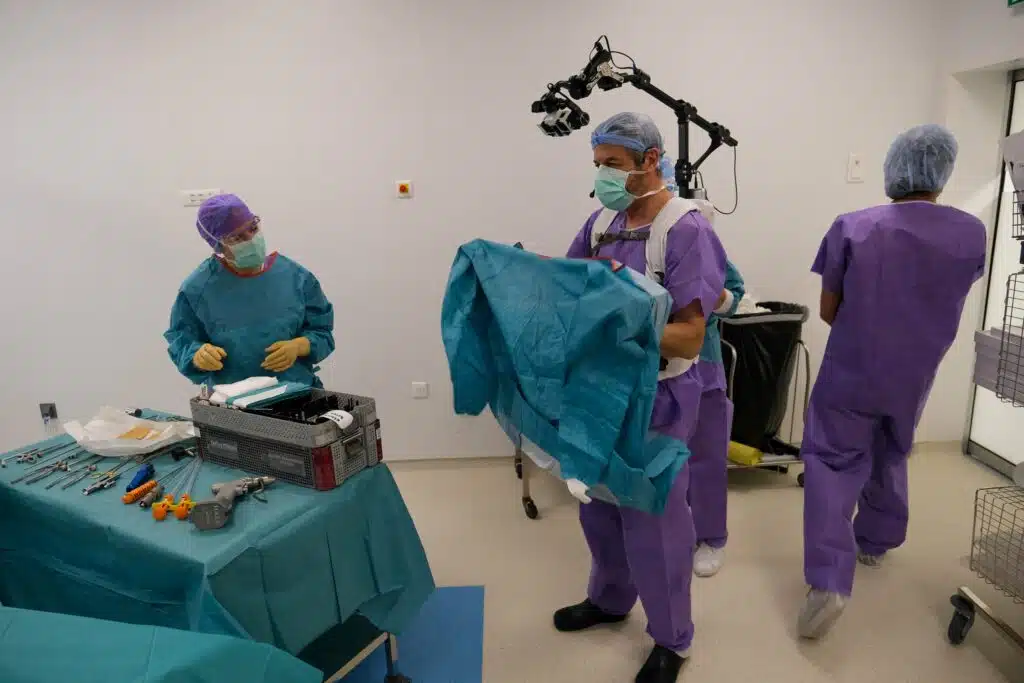The project is a little “crazy.” Maxime Ros admits it himself. Ros is a neurosurgeon, a former chief resident at University Hospital of Montpellier, and copresident of Revinax, a company specialized in virtual reality technologies that he founded in 2015.
He got the idea to film the twenty or so operative techniques that are required knowledge for each specialty under real-life conditions, all aimed at surgical interns. Do the math: with thirteen surgical specialities, that comes to more than two hundred and fifty tutorials to be filmed. The images can then be viewed using a virtual reality headset.

The digital recording device developed by Revinax for use in tutorials for surgeons
SYLVAIN TEISSIER/REVINAX
Why on earth would this doctor pass up a university career to become an entrepreneur? Let’s go back to 2012. Ros completed his internship in neurosurgery in Toulouse that year, but no chief residency was available. The young surgeon then began a sort of “tour” of fellowships at hospitals around France: Hôpital de la Timone Enfants (Timone Children’s Hospital), in Marseille, then the Pellegrin hospital group, in Bordeaux, followed by Hôpital Necker-Enfants Malades (Necker Hospital for Sick Children) in Paris and, finally, University Hospital of Montpellier, where he was offered the position of chief resident in neurosurgery.
“It may seem surprising, but several times during my fellowships, I ended up assisting the master surgeons in their last surgeries before they left for retirement. This allowed me to observe their absolute mastery of the technique,” he remembers. “But how could I remember all of the smallest details? How could I approach this perfection as closely as possible without having the same viewing angle as main player?” He couldn’t stop thinking of how to convey the right movements by archiving them. The idea was to place the intern in the same line of view as the surgeon performing the operation rather than beside or facing the surgeon as is conventionally done. According to him, the best way to do this is to film exactly what the surgeon sees. The surgeon will be the cameraman. Even if the intern isn’t performing the procedures, the intern’s brain records the operation through the activation of mirror neurons, brain cells that are activated when we perform an action, but also when we see someone else perform an action,” Ros explains.
The surgeon is fitted with a harness, surmounted by an arm attached to the back that comes up and over the head, holding a stabilization system to which two 3D 180-degree cameras are attached. The videos from these two cameras are synchronized and stitched together side by side to obtain a stereoscopic film. The film is then edited and divided into chapters based on the different surgical steps and supplemented with additional data, such as medical imaging slices and three-dimensional anatomical objects.
“A Pilot Test for Bringing It All Together”
To film these videos, Revinax will use the SimLife technology of the company Simedys. This startup is the result of research done by the biomechanical anatomy and simulation laboratory of the Faculty of Medicine of Poitiers. It restores semblance of life to a fresh cadaver donated to science. Using this procedure, the body is reventilated – the lungs inflate, causing the other organs to move¾and revascularized by pumps connected to the arteries and veins, so that a liquid with the same color and biomechanical components as blood circulates in the vessels.
A first series of operations is expected to begin in the spring at the anatomy laboratory of Côte d’Azur, in Nice. It involves filming “surgical damage control” procedures, that is, the entire surgical process every surgeon needs to know for treating trauma patients with severe hemorrhaging.
“It’s a good pilot test pilot for bringing it all together because it’s very cross-disciplinary. There will be about thirty operations to film,” he explained.
There is also a plan to film real patients at a rate of twelve to sixteen tutorials per year. All of these videos will be added to a catalog of two hundred videos.
Some of them cover patient care and are aimed at nurses and nurse’s aides. They are viewed using a virtual reality headset, to be provided by the universities. But they can also be viewed using a mobile application coupled with a small cardboard headset equipped with ocular lenses by simply sliding the smartphone into the slot in the headset, turning it into a screen.
In both cases, the effect is pretty mind-blowing: the user is transported to the operating room and plunged into the middle of the operation through the eyes of the main players.





